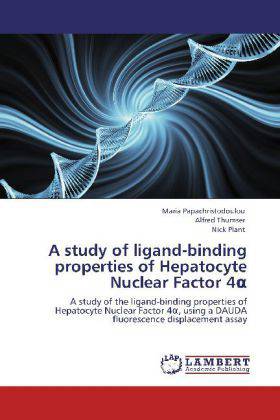
- Afhalen na 1 uur in een winkel met voorraad
- Gratis thuislevering in België vanaf € 30
- Ruim aanbod met 7 miljoen producten
- Afhalen na 1 uur in een winkel met voorraad
- Gratis thuislevering in België vanaf € 30
- Ruim aanbod met 7 miljoen producten
Zoeken
A study of ligand-binding properties of Hepatocyte Nuclear Factor 4
A study of the ligand-binding properties of Hepatocyte Nuclear Factor 4 , using a DAUDA fluorescence displacement assay
Maria Papachristodoulou, Alfred Thumser, Nick Plant
Paperback | Engels
€ 104,45
+ 208 punten
Omschrijving
Hepatocyte nuclear factor 4 (HNF4 ) is a liver enriched transcription factor that belongs to the nuclear receptor family, and controls the expression of genes involved in various different functions, such as nutrient transport, metabolism, growth and differentiation. Recently, fatty acids and/or fatty acyl CoAs as well as some xenobiotics (e.g. hypolipidemic drugs) have been suggested as HNF4 ligands. The aim of this study was to identify potential ligands for HNF4 , using a DAUDA fluorescence displacement assay. LFABP was expressed and purified as a positive control, and used successfully to validate the DAUDA assay. Rat HNF4 LBD was successfully expressed and purified, therefore further work for ligand identification was performed using the rat HNF4 . Suitability of the DAUDA fluorescence displacement assay for screening of ligands for rat HNF4 was confirmed by a characteristic blue shift in fluorescence emission upon protein binding, as previously reported. Ligands screened in this study included five different fatty acids, palmitoyl CoA, and hypolipidemic xenobiotics of the fibrate family (fenofibrate, bezafibrate, clofibrate), as well as pioglitazone (a thionolidinedione).
Specificaties
Betrokkenen
- Auteur(s):
- Uitgeverij:
Inhoud
- Aantal bladzijden:
- 220
- Taal:
- Engels
Eigenschappen
- Productcode (EAN):
- 9783846580820
- Verschijningsdatum:
- 22/02/2012
- Uitvoering:
- Paperback
- Afmetingen:
- 152 mm x 220 mm
- Gewicht:
- 327 g

Alleen bij Standaard Boekhandel
+ 208 punten op je klantenkaart van Standaard Boekhandel
Beoordelingen
We publiceren alleen reviews die voldoen aan de voorwaarden voor reviews. Bekijk onze voorwaarden voor reviews.








